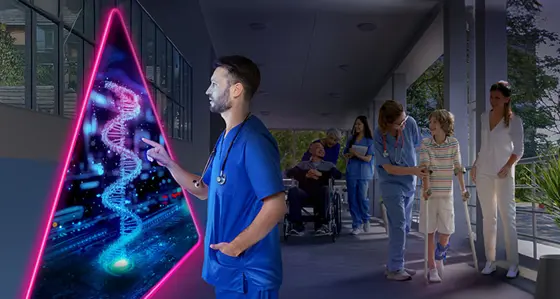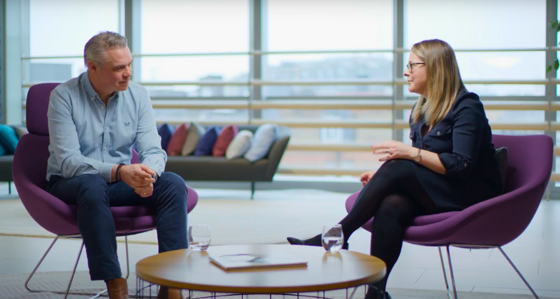
Scaling patient engagement across R&D
Live interactive workshop at Patients as Partners Europe 2024
8 min read 5 July 2024
In May, Baringa’s Pharmaceuticals and Life Sciences team attended Patients as Partners Europe 2024 to host a live interactive workshop with close to 200 attendees, delving into the intricacies of scaling patient engagement across R&D.
Our session was a unique opportunity to bring together diverse perspectives to explore how the industry is partnering with patients and their communities, to design and run clinical trials deploying innovative solutions and insight. We were keen to understand the impact these partnerships are having on the experience of participants and the speed, cost, and quality of trial delivery.
We involved the whole audience including one group of patients, patient advocates and patient-focused organisations so we could deep dive into their lived experiences and capture their top challenges. The remaining groups focused on the experience from industry colleagues considering:
- Organisation, people and sustained capability building
- Processes, procedures and ways of working
- Enabling tools and systems
- Governance and impact measures
Patient experience: ‘Back to basics’
Patients are increasingly vocal about their desire for improved access to clinical trials and are calling for better ways to learn about available trials and seeking more support to participate in them. Industry has a crucial role to play in raising public awareness and tailoring communication about the benefits of clinical trials to the communities that will benefit the most from them. Greater acknowledgement that every patient is unique and addressing this commitment through designing innovative, personalised endpoints and pushing patient-reported outcomes (PROs) higher up in endpoint prioritisation is key, particularly when considering diversity and accessibility.
Incorporating clinical trials into treatment pathways can provide patients from all backgrounds with the opportunity to access groundbreaking new medicines, diagnostics, and predictive technologies. Designing trials for diverse patient archetypes and co-designing them with the community, putting the patient voice at the forefront of clinical trial considerations from the beginning, is essential. However, it is important to not overlook the simple, yet essential support patients and their families need for their participation to be effective. Logistical support for transportation, accommodation, and meals is vital, and the industry can significantly enhance the patient experience by ensuring these basics are in place.
Organisation, people and sustained capability building: ‘Mindsets and myth busting’
Shifting mindsets within the organisation remains the main challenge for many patient engagement teams. Organisations are at different stages in their patient engagement journey and each company faces its own unique challenges in this space. Companies are focusing on internal training and engagement, publicising proof of impact and candidly sharing areas for improvement to foster a growth mindset amongst teams and leadership.
One significant barrier that needs to be addressed is the prevailing culture of fear. Dispelling myths, particularly surrounding local regulations is essential. Local teams are well-positioned to establish meaningful and enduring relationships with patient organisations, policy makers, payers, government bodies, and healthcare professionals. Providing greater support to local teams in understanding the dos and don'ts and dispelling myths, equipping them with the necessary structure and tools to effectively partner with patients is key.
Achieving a mature, decentralised approach will only be feasible once capability is firmly established and there is strong global to local alignment. This encourages the establishment of internal feedback loops for local input into global design and the sharing of local insights. Furthermore, funding of local initiatives should be a focal point of planning conversations, accounting for the development of materials tailored to resonate with local communities and encompass all aspects of diversity.
Processes, procedures and ways of working: ‘Quality over quantity’
Companies need to assess their chosen methods used to gather patient insights and focus on quality over quantity. It was consensus from the group that richer insight is obtained through co-creation, collaborative meetings, and qualitative interviews with patients and community. Creating actionable outcomes from the gathered insights is the next critical aspect of integrating patient experience data into trial designs. This relies on understanding individual patient journeys from symptom to diagnosis from a set of diverse patient archetypes, and using these insights to inform protocol development strategy. Post-trial surveys to feed insights into future trial design is another way to demonstrate commitment to continuous improvement based on patient feedback. It was clear from this years’ conference that there is still progress to be made with the quality and rigor of patient communication during clinical trial enrolment.
In recent years there has been an ongoing shift to outsourcing of clinical trials. It is essential that your internal principles and cultural behaviours are aligned with your chosen CRO & investigators. Considerations should be made when selecting and contracting third parties, to address DE&I commitments and assess whether they represent the diversity of your participants. It is important to ensure your partners are sufficiently trained to have meaningful engagements with patients. One opportunity to support with this education is the greater inclusion of third-party vendors in coalitions and PE professional networks.
Enabling tools and systems: ‘Essential to be central’
The value of seeking and sharing patient insights across the end-to-end product lifecycle is recognised by all. By having access to real-time patient insights in conjunction with current insights from conversations with healthcare professionals, payers, regulators and governing bodies, cross-functional teams can create a clearer picture of the patient experience and the evolving healthcare landscape. For this to have the desired impact, existing systems need to be integrated and data sources streamlined, to allow insights captured from different teams or functions to be stored in easily accessible, central locations. Combining these insights with up-to-date clinical trial performance data will help improve efficiency of decision-making, reduce duplicated efforts and ultimately, have a meaningful impact on patient outcomes across the full product lifecycle.
Many companies are relying on manual and subjective processes for uploading insights, leading to low adoption of existing systems. There are many use cases for AI-driven solutions to automate data entry and the insight generation processes, as well as simplifying the creation of patient-related content into layman-friendly formats. Whilst there is a large opportunity to harness these solutions and reduce internal administrative burden, the inherent complexity of implementing such solutions should not be overlooked.
Insights generated from patient data are only valuable if they’re actionable and the accountability for these actions needs to be clear. Matching insights to strategic objectives is one way to drive action and provide greater visibility amongst cross-functional teams. Patients want to know how their insights have made a difference and the feedback loop must be closed, irrespective of the advice seeking activity.
Early consideration of compliance to address sensitivity and access to patient data is needed. Data/ Records Retention laws and guidance must be followed, as well as clear communication with patients during the often highly complex external contracting process.
Governance and impact measures: ‘Measure what matters’
Having a single source to access patient insights, allows traditional siloes in the industry to be broken down. Continuous engagement across the product lifecycle, reflecting on new insight and using outcomes to demonstrate impact is required. Some companies are exploring this through developing logic modelling frameworks to support teams to frame their impact narratives. This involves aligning the direct outcomes of patient engagement to the wider and long-term desirable consequences and demonstrating the impact for patients, HCPs, the wider healthcare system and their business.
Patient-focused teams need to partner more closely with clinical operations teams to understand the opportunity to link patient outcomes to clinical trial outcomes and derive results such as reducing the number of protocol amendments or protocol deviations, improving speed of recruitment and retention rates, or reducing the need for additional sites to be opened.
There was a resounding desire for stronger, mandated guidelines from external governing bodies as well as an ask to distil existing guidelines to help improve agility.
Actions for impact
- Diversity by design: Engaging with diverse patient populations and improving their access to quality healthcare can be a complex landscape to navigate. Co-creation is a powerful tool when all stakeholders are invited to the table and communities are involved early – by doing so, trials are created with diversity by design.
- Data integration revolution: Traditional siloes in the industry add to the existing complexities of embedding the patient voice across the product life cycle. Leveraging insights derived from patient data, triangulated with operational performance will create insight that improves patient outcomes and delivers business impact.
- The patient engagement value wheel: At Baringa, we have a way of operating that puts our people first. We believe by focusing on our people we deliver high quality work for our clients that in turn drives better outcomes for our firm. The same can be applied to patient engagement. By systematically seeking patient insights, you will improve the impact of your science, giving your people purpose and delivering against your commercial objectives, keeping patients at the core of everything you do.
To find out more about how Baringa’s expertise can unlock your ability to scale patient engagement in R&D, please get in touch with Kate Moss, Kara Prosser and Laveshni Reddy.
Our Experts


Related Insights

Unlocking the business value from AI in Pharma
Drawing on our experience, we explore four areas where life sciences companies frequently fall short – and outline the critical enablers to achieving both scale and value from AI investments.
Read more
Unlocking the Value of AI in Pharma
Discover how pharma can unlock AI’s full value, boosting innovation, trust, and outcomes through data, governance, and team upskilling.
Read more
The Power of Partnerships across the healthcare ecosystem: how can Biopharma take the lead?
The healthcare ecosystem encompasses a diverse range of organisations with a shared goal: to provide high quality and affordable healthcare. However, as this goal becomes increasingly challenging to maintain, Biopharma organisations play a key role in strategically partnering across the ecosystem to improve health outcomes.
Read more
Optimising Clinical Development ways of working in a strategically outsourced model
Transforming clinical development with a single strategic partner, reducing documentation by 36% and improving oversight and efficiency.
Read moreRelated Client Stories

How Baringa supported Colt Technology with its CRM transformation
Join our TMT Partner Dan Nicholson, as he talks to our client Colt Technology
Read more
We talk to our client KCOM about modernising business operations
Join our TMT Director Sarah Roberts, as she talks to our client Tim Shaw, CEO at KCOM
Read more
Building a trusted data platform to enable scaling and cost savings
How do you accelerate delivery of a £multi-billion network expansion programme using advanced analytics and targeted insight?
Read more
Developing a Target State Operating Model for a technology and language services provider
Developing a comprehensive high-level target state operating model, defining the process architecture, and modelling the necessary capabilities for success.
Read moreIs digital and AI delivering what your business needs?
Digital and AI can solve your toughest challenges and elevate your business performance. But success isn’t always straightforward. Where can you unlock opportunity? And what does it take to set the foundation for lasting success?